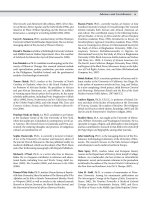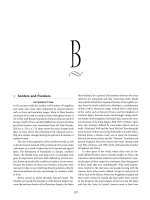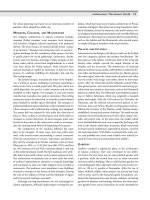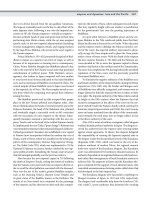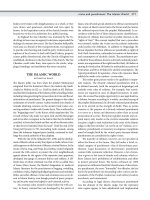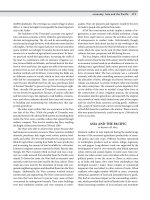Encyclopedia of society and culture in the medieval world (4 volume set) ( facts on file library of world history ) ( PDFDrive ) 49
Bạn đang xem bản rút gọn của tài liệu. Xem và tải ngay bản đầy đủ của tài liệu tại đây (60.86 KB, 1 trang )
22 agriculture: The Americas
suited the particular ecosystem. For example, in the flood
plains of desert areas, groups farmed by taking advantage of
seasonal floods to water and fertilize their fields.
In the Americas agriculture was a part of both everyday existence and sacred practices. The native people of the
American Southwest celebrated the Green Corn Ceremony
late in the summer when the corn was becoming ripe enough
to eat. The ceremony, which lasted several days, symbolized
the beginning of a new year, the renewal of the community,
and a time of cleansing. In preparation for the ceremony,
public buildings and areas were cleaned and repaired. The
ceremony also included fasting and the use of plant infusions
in an effort to “cleanse” the body.
South America
In Costa Rica and many other places in South America slashand-burn agriculture was typical. In general each family
group was allotted a parcel of land to work, and the allocations
shifted when fertility dropped off. Men cleared and burned
the vegetation while women planted and harvested the crops.
Communal agricultural labor, which is still practiced among
some modern indigenous groups, usually involved men assembling at the residence of the landowner and working in a
group to accomplish a particular goal.
The natural environment dictates how people grow crops.
The central Andes of western South America is a diverse geographical landscape that demands that its inhabitants develop
various techniques to grow food. On the Andean coast people
originally settled along the shoreline, but by 1800 b.c.e. they
began moving inland, constructing irrigation canals to help
them grow food. By 1200 c.e. irrigation networks on the far
northern coast connected as many as five river valleys. The
Nazca people tapped into the water table using a system that
they developed around 500 c.e. and which is still largely in use
today. They constructed underground aqueducts or filtration
galleries that minimized evaporation and terminated in reservoirs and irrigation canals. Among the crops they planted
were cotton, squash, gourds, and beans. Andean groups in the
highlands developed trading relationships to gather whatever
they could from coastal people: dried fish, marine salt, seaweed, and coastal crops. Because a real market system did
not exist in the Andes, marketplaces were very rare. Groups
established special political ties among themselves, and societies spurred the exchange of most commodities. One useful
method exploited by highlanders, in particular, was establishing enclaves in various ecosystems, thus allowing for a
more even distribution of resources.
Different social groups in the Andes developed their agricultural lands in different ways. In the tropical forest areas
slash-and-burn technique produced coca leaves; medicinal
plants; and foods like manioc, peanuts, and sweet potatoes. Andean farmers used the chakitakylla, or foot plow, to
tend their fields. Other places required intense agricultural
techniques. The city of Tiwanaku (ca. 100–ca. 1000) was a
prosperous urban center where some houses had wells and
drainage systems. The key to its prosperity and longevity was
its rural hinterland, devoted to growing crops in raised fields,
herding llamas and alpacas, and exploiting the fish and birds
living along the shores of Lake Titicaca. Andean pastoralists may have domesticated the llama in this area as early as
3500 b.c.e. Llamas were a source of meat and served as beasts
of burden. Alpacas were also domesticated to provide wool
for weaving into cloth. Contemporary native groups still use
these animals in much the same ways.
Andean farmers devised raised-field systems called waru
waru that made wetlands productive and somewhat protected
from damage. The water in the canals between the cultivated
ridges acted like a series of miniature lakes, absorbing the solar radiation during the day and releasing the conserved heat
at night, thus decreasing frost damage. Waru waru systems
increased harvests and ensured a dependable food source in
a region beset by droughts, hail, frost, torrential rains, and
strong winds. Tiwanaku also established agricultural “estates”—areas used specifically for intense agriculture. This
particular model was followed by many other Andean peoples, including the Inca.
By the mid-1400s the Inca had established themselves
as the most powerful group in the Andes, and their ability
to exploit their natural resources largely contributed to their
success. They used the technique of terracing to dramatically
increase the amount of arable land they had available. Terraces are essentially huge window boxes that convert mountainsides into stepped fields. The Inca built retaining walls
of fieldstone, scooped out the packed earth, laid a layer of
stones at the bottom for water drainage, and loosely repacked
the earth. With canals supplying water, these terraces could
withstand frost and drought and produce several crops each
growing season. The Inca developed the most extensive network of terraces that the highlands have ever known. Agricultural terraces such as that at Pisac, near the Urubamba River
northeast of Cuzco, were extensive. Other terraces seem to
have been primarily decorative; for instance, at Ollantaytambo, also near Cuzco, terraces displayed flowers. The Inca
also did terracing in places without apparent water sources,
suggesting that the technique was also seen as an important
aesthetic form.
Mesoamerica
As populations grew the Maya opened new lands to cultivation and developed new methods to increase crop yields.

